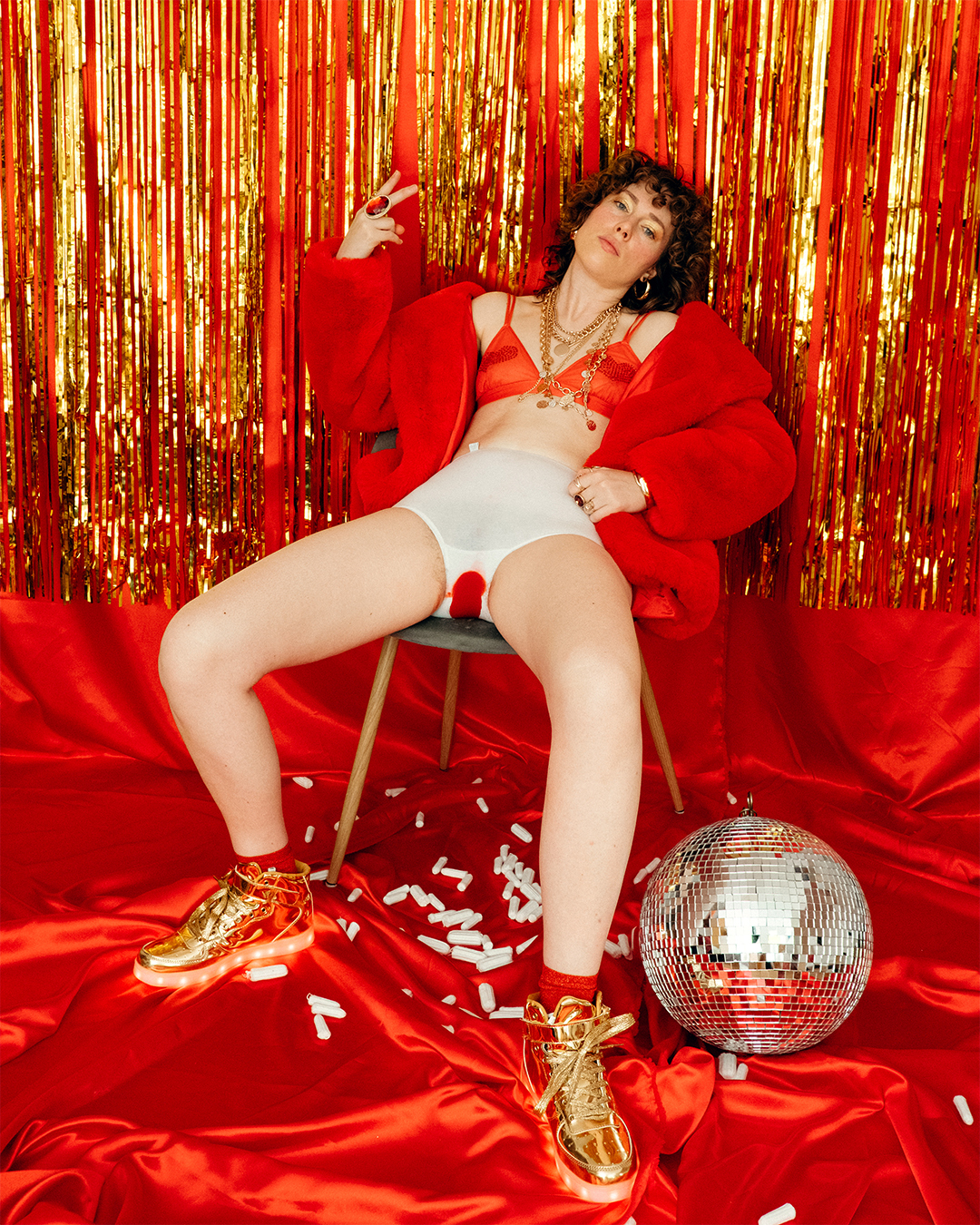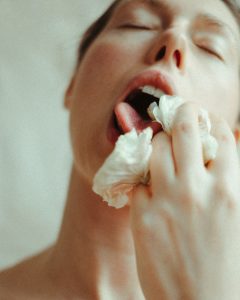
Getting creative: the feminine twist in a masculinist movement
by Chloe Banks | July 21, 2022
Many thanks to Monika Kozub for providing the images to illustrate this article. It means so much to be supported by a creative I admire and whose work has inspired me in many ways. Please check out her PERIOD series, which is part of a campaign to tackle period poverty!
On a red-velvet chair, I sat in the main screen of a small cinema in Berlin, the theatre buzzing with anticipation. The seats were filled with a diverse crowd who, like myself, were keen not to miss this screening of three short movies, presented in person by their director: ethical porn producer, feminist, and my personal icon, Erika Lust. The audience were treated to a seductive selection of films from her “XConfessions” series. Erika Lust crowdsources the storylines for these productions from real fans, turning their X-rated confessions into erotic shorts that one could describe as poetry for the senses.
But there is so much more to Lust’s porn than the sex. Her work is cinematographic artistry: progressive, inclusive, and deliciously lavish. The films are wonderfully rich, from the atmospheric music to the luscious colour palettes that help set a tone of opulence in which those watching can truly lose themselves.

What does this night back in 2018 have to do with decadence and its relevance to intersectional feminism today? Decadence has always been associated with excessive indulgence in gratification, and eroticism is a consistent feature of decadent art from different periods of time. As such, Erika Lust’s work, and my memory of this event, provide the perfect jumping off point for discussing the potential of the relationship between decadence and feminism, despite a history of uncomfortable coexistence between the two. The male-dominated world of Western decadent movements has typically been regarded as anti-feminist and intrinsically misogynistic. Even women, such as author Marguerite Vallette-Eymery who wrote the provocative “Monsieur Venus” under her preferred penname Rachilde, refuted the label of feminism for their work. And we need only look to Baudelaire for evidence of the sexist dimensions of Victorian decadence: he acrimoniously declared in his Journaux intimes that women were “abominable” owing to their embodied, and therefore inescapable, connection to nature. This view was shared by most Victorian-era decadents, as was his sense of white, male superiority. In fact, many of the still-popular figures associated with the decadent movement are male: for example, in The Picture of Dorian Gray, Oscar Wilde presented Sybil Vane as insipid and, as his character Henry Wotton suggests, “a decorative sex.” Despite male decadent artists featuring women prominently in their work, these representations remained carefully curated to fit the Western male gaze. Female bodies were co-opted to fulfil the sensual aestheticisms that decadence aspired to and sexualised feminity was separated from the bounds of women’s corporeality.
It is also fitting that the venue chosen for the screening of Lust’s films is an architectural legacy of Weimar-Republic splendour, a cinema found in all its vintage glory on the corner of the Rosa-Luxemburg-Strasse. Weimar Berlin (1919-1933) was notorious for its decadence and the celebration of hedonistic excess. In many ways it remains as much a haven for artists, intellectuals, and innovators today as it did then. The decadents of inter-war Europe, much like their Victorian predecessors, consistently drew on themes of the erotic for inspiration and creative expression. Their work delighted in excess, frivolity and, most importantly, the rejection of naturalised societal norms. The decadent female figure had a key role to play in this and became heavily embodied by the ‘New Woman.’ Here was a woman who had grown bored of the traditional roles of dutiful daughter, wife, and mother, and instead she pursues the delights of self-indulgence. This figure is no better expressed than in Irmgard Keun’s 1933 novel The Artificial Silk Girl, in which Keun brings to life Weimar-era Berlin through the eyes of protagonist 18-year-old Doris, the epitome of the decadent ‘New Woman.’ This decadent woman came to represent one of the greatest threats to conventional society – she embodied the very perils of societal change and degradation which conservative critics most feared. In this sense, she was a dangerous woman.

The work of some early female decadents like Keun signify ways in which thedecadent movement might have aligned itself with early feminisms. And yet, despite opposing conservative trends and morals, decadent movements in general were equally as uncomfortable with women embracing their sensuality for themselves. In both camps, great lengths were taken to control and curtail women’s sexuality, albeit for different reasons. To conservative critics, the decadent woman threatened their outmoded status quo. To male decadent artists, women represented a threat to the rejection of nature which was central to their artistic worldview.
There is a well-known piece of decadent work by J. K. Huymsmans that is in fact titled Against Nature. It features an explicit expression of the general decadent attitude regarding nature, and the implicit sexism underlying it. His aesthete protagonist, Des Esseintes, declares about nature that “this eternal, drivelling, old woman is no longer admired by true artists, and the moment has come to replace her by artifice.” Des Esseintes’ gendering of nature here has been a common feature of historical cultural discourse. Feminist criticism has explored how the masculinist and colonial traditions of conquering nature has enabled the justification for sexism, and vice versa. Just as decadents felt that artistic creativity of men was the only thing which could allow nature to transcend its banal reality, they believed that only genius male artists could shape the female form into something acceptable or desirable.
The threat of self-determined female sexuality is what transforms decadence into a powerful feminist tool, as much back then as now. Scrolling through the Instagram page of @berlinboudoir, it is clear to see that the Berlin based photographer Monika Kozub embraces luxury in her celebration of female sensuality. Sumptuous tones and textures adorn her page. Neon lights, fruits, glitter, flowers, lace – her work oozes opulence, edged with realism. Through her incredible photography and portraitures, Kozub captures the range of female beauty that exists in the world by foregrounding themes of nature and sexuality as tools of empowerment for women. Through her work she highlights the decadence that is womanly existence, and the strength and joy that this can provide. Similar to the work of Lust, here is contemporary decadent art that is not only created by women, but by women who welcome their feminist status and champion this through expressions of decadence.

Even though female artists during both the Victorian and interwar decadent movements may not have labelled themselves as feminists, there is no doubt that they helped pave a way for any explicitly feminist decadence that contemporary artists express in their work. The poetry of Renee Vivien (1877-1909) offers opportunity to explore how many female decadents created powerful and subversive work that also differentiates itself from the familiar, canonical impressions of decadence as irreconcilable with feminist work. Vivien is considered by many contemporary feminists to be the first woman to openly write lesbian poetry. Her preference for writing sonnets may seem incongruous with any aims to free her verse from heteronormativity, especially considering Gertrude Stein’s critique of the sonnet as a form of “patriarchal poetry.” However, Vivien used its structure to her advantage, helping her navigate the prejudices towards female writers of her time. Both Vivien’s creative content and her political decision-making regarding its publication signify ways in which she pre-empted contemporary feminist and queer theory. As Vivien did in her love poems inspired by her first relationship with the heiress Natalie Barney, female decadents drew on their individual experiences to emphasise difference in their work. The effect was arguably more political than the work of their male counterparts: female decadents found themselves opposing the conservative norms of the world at large and yet still were not taken seriously as artists in the boy’s club of decadent movements. Caught on the margins of both the accepted standard as well as the decadent opposition to this, their work was all the more avant-garde and subversive.
The development of feminism in all its variations during the 20th and 21st century has created opportunities for contemporary female creatives to expand on the activist potentials of decadence. Personality and diversity lie at the heart of decadent work by women, and as such offers a significant means by which contemporary feminists can pursue intersectionality with greater success. Maya Angelou’s ‘Phenomenal Woman’ champions her marginalised femininity, celebrating her black body as an act of strength and rebellion against the Eurocentric beauty ideals which were often perpetuated in the work of white, middle-class feminists. Sofia Coppola’s films have been critiqued for narrowly representing that privileged, white, middle-class version of feminity – however, her scenes of indulgent languor veiled in hushed, pastel tones reframe delicate feminity in such a way which reflects gendered limitations that women can face, leaving her characters trapped and reduced by expectations of feminine ideals, including their own. Despite their differences, both Angelou and Coppola speak to the subversive nature of decadent sensuality and engage in reclaiming the aesthetics of femininity.

Intersectionality demands us to respect that there is no one-size-fits-all feminist answer to the problems faced by women. Whether it is the hood feminism of Mikki Kendall or the bimbo feminism of Chrissy Chlapecka, feminism represents subgroups in different but equally necessary ways. Diversity and complexity are what today’s intersectional feminism strives to appropriately understand and apply. Adopting decadence offers a unique opportunity for women to challenge the aesthetics of female pleasure, sensuality, and womanhood, previously oriented towards the male gaze. And just as it has always enabled decadents to challenge societal norms, feminist decadence has the potential to empower women in challenging patriarchal processes of normativity, as well as internalised structures of inequality and hypocrisy that can be found in feminism itself. The act of knowing what we want, of unapologetic self-acceptance and the expression of this is not only a decadent act, but in a society that normalises conforming to standards, it is an act of rebellion. Contemporary female artists co-option of decadence not only rejects of the societal standards of a patriarchal cultural system, but also defies the gendered history of decadence itself.
As a woman and feminist myself, I truly believe that decadence provides a unique opportunity for us to confront reductionist attitudes to women and embrace a more holistic view of ourselves, rather than defining and delineating between ‘feminine’ and feminist. The materialistic and hedonistic qualities of 19th century decadence were mostly accessible to wealthy, white men, which would explain the male dominance of the movement. However, it was female artists who played a key role in establishing the message that the experiences of excess and erotic delight go beyond the domain of men. And while they may not have aligned themselves explicitly with feminist aims for gender equality, they have still paved the way for latter-day female decadents. Contemporary female creatives are bridging the divide between feminism and decadence, and in doing so they are rediscovering and rewriting the decadent woman as a character of substance that is all her own. This new, feminist power – the decadence of finding pleasure in our unique selves – connects, empowers, and makes us a threat. Let’s get creative and embrace our dangerous decadence.∎
Words by Chloe Banks. Art by Monika Kozub.




